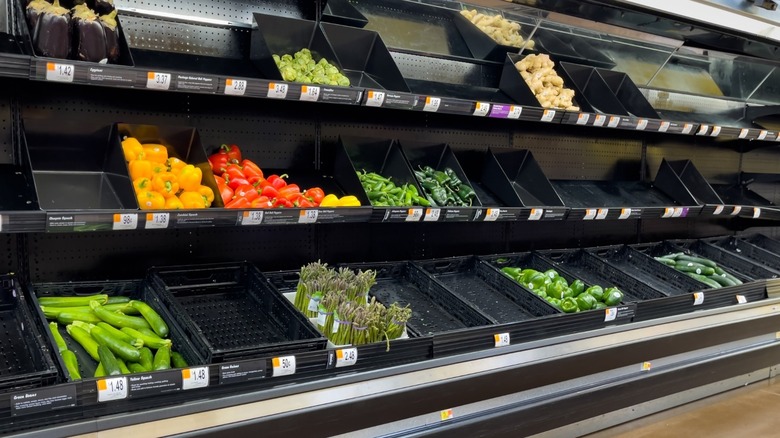Why Food Shortages Might Drag On For Years
With the 7-day COVID-19 case-rate decreasing, per the CDC, it's tempting to start letting go of some of those rationalizations we've all been making about "this" being the "new normal." For example, since the pandemic damaged the U.S. labor supply, and the labor shortage negatively impacted the overall supply chain, shouldn't it be reasonable to expect that if infection rates decrease and more people re-enter the work-force, then maybe, just maybe, we might soon reach the end of that long expanse of empty supermarket shelves, whose days began with early-pandemic hoarding and never really stopped?
Indeed, the USDA assures the nation that at this point in time, there are "no nationwide shortages of food" and "no wide-spread disruptions" in the U.S. food supply chain. But if that's the case, then why does it still feel like it's touch-and-go in virtually every aisle of the supermarket? From apples to zucchini bread, food is still in short supply, as you can see with your own eyes. And even while denying the existence of a "shortage," the USDA acknowledges that "inventory" may be "temporarily low before stores can restock."
Although our nation is not currently in "shortage" mode, and despite the World Bank acknowledging as recently as today that "the outlook for global food supplies remains favorable," the fact is that food supplies remain unstable throughout the U.S. and the world as a whole. Accordingly, discussions of food shortage and insecurity could drag on for years.
A global food shortage has long been brewing
COVID-19 dramatically disrupted the global food trade, but the circumstances had long been building. According to the World Bank, even prior to the pandemic, food insecurity was on the rise throughout the globe due to "various factors, including conflict, socio-economic conditions, natural hazards, climate change and pests."
While COVID-19 may be retreating, the same cannot be said of even one of these other factors. Moreover, the World Bank predicts that "COVID-19 uncertainties and disruptions still continue," a reality that would appear to bode poorly for an end to food shortage concerns as we move forward in the near term. Adding insult to injury, Russia's war against Ukraine has further disrupted international trade overall, which in turn, has negatively impacted the food supply chain.
As just one example, Russia's position as the world's biggest supplier of fertilizer ingredients, such as natural gas and potash, has already significantly increased the price of fertilizing crops throughout the world (via RetailWire). At the same time, and to some extent, as a result, fertilizer supply in the U.S. is down by as much as 50% of estimated requirements, per AgWeb. This does not bode well for U.S. crops, including wheat, for which we are second only to Russia in export volume.
So, while the USDA cites no current U.S. food shortage, the U.S. does not exist in a vacuum. Unsurprisingly, experts like World Bank predict global food insecurity issues will worsen through at least the end of 2022.

